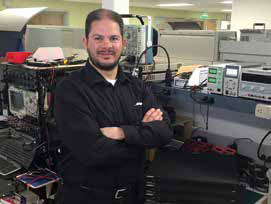
The new line of Bose PowerShare adaptable power amplifiers is designed to be plug-and-play, but also offers additional layers of features for the integrator that prefers to really dig in to system optimization. Bose Professional is unveiling its new line of Bose PowerShare adaptable power amplifiers at InfoComm 2016. The new product line uses patented Bose technology that enables each amplifier’s total power to be shared across the outputs as needed.
There are three 1U models in the new PowerShare line: the two-channel PS602 and four-channel PS604, both intended for permanent installation, and the PS602P portable version. “They all have a reservoir of 600 watts and give you the ability to share the total power across all outputs,” said Ashraf Elghamrawi, amplifier product line manager. Shipping is scheduled to begin July 2016.
“In a traditional 200-watts-per-channel amplifier, if one output channel is driving a 20-watt speaker in a small room, 180 watts is effectively left on the table,” Elghamrawi said. “But with PowerShare, if you only want 20 watts on an output, you can give it 20 watts.”
In his role within Bose, Elghamrawi interfaces between the company’s engineering department and customers. “Through the process of talking with customers, the team determined that previously introduced PowerShare technology would be very useful in a new amplifier product,” he said.
“It’s a patented technology that we’ve re-leveraged. We saw what the technology was capable of, and we made advancements to it by adding a software interface and remote control capabilities that directly connect to the amplifier. That rounded out what our commercial integrators needed from an amplifier with PowerShare capability.”

Ashraf Elghamrawi, amplifier product line manager, Bose Professional The concept really resonated with integrators and installers, he said. “It’s very common for an installer to be commissioned for a design—say, a retail or restaurant application—where they need maybe 500 watts on the job. Then the customer says, ‘We’re going to make the main dining room a little bit bigger,’ and they need another 100 watts. Now the requirement exceeds the channel wattage but not the amplifier’s total capacity.
“With PowerShare, you don’t have to buy a second amplifier or a larger amplifier. You can take the surplus wattage from zone two and apply it to zone one. That’s why we’ve called it the PowerShare adaptable amplifier line. It gives you that level of flexibility and adaptability.”
PowerShare takes its place in the Bose product catalog between the FreeSpace amplifier products, which are aimed at commercial applications, and the PowerMatch configurable amplifiers for permanent installations in large venues. “We leveraged the simplicity of FreeSpace with the technology of PowerMatch to span that gap,” said Elghamrawi.
“In fact, PowerShare takes some of its technology from PowerMatch. We use the DFL [Dual Feedback Loop] system that was inherited from the field-proven PowerMatch line, where we’re continuously monitoring and controlling the current and voltage out of the amplifier. We’re ensuring sound quality while protecting both the amplifier and downstream loudspeakers.”
The new amplifiers also offer what Bose calls load-independent outputs. “Each channel is independently configurable for lo-Z or hi-Z. So whether your loudspeaker load is four or eight ohms, or 70 volts or 100 volts per channel, the amplifier can deliver full power into any of those configurations,” he said.
The new line is designed to be plug-and-play, but also offers additional layers of features for the integrator who prefers to really dig in to system optimization. Enabled via USB connection, PowerShare Editor software provides optional access to more comprehensive control, including loudspeaker processing such as nine-band parametric EQ, crossover, limiters, delay and mixing features, as well as real-time selection and control of Bose loudspeaker EQ settings.
“There are EQ dials on the back of the amplifier,” said Elghamrawi. “For 10 of our most popular loudspeakers, you can set the EQ and the amplifier is ready without the software. The amplifier was optimized to be taken out of the box, set a few switches, and amplify audio as quickly as possible. When you set the EQ, the limiter and crossover settings for that loudspeaker automatically get loaded as well.”
Also new in July, the new Bose ControlCenter CC-1 zone controllers may be directly attached to the PS602 or PS604 for remote adjustment of the outputs. “Since the controllers connect directly to the amplifier, that eliminates the need for an additional signal processor in many installations,” he said. “With the addition of the PowerShare Adaptable power amplifier line, our customers can now drive any of our loudspeakers with a Bose amplifier.”
Steve Harvey (sharvey.prosound@gmail.com) is editor-at-large for Pro Sound News and also contributes to TV Technology, MIX, and other NewBay titles. He has worked in the pro audio industry since November 1980.
